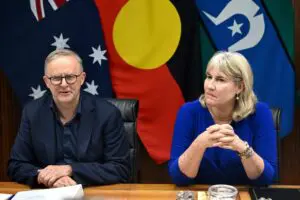Australia’s largest state farming organisation, NSW Farmers, is calling for a temporary ban on the construction of new large-scale solar farms in the state, amid concerns developers are not acting in the long-term interests of regional communities.
In a motion passed at the Association’s 2023 annual conference last week, NSW Farmers agreed to call on the state Labor government to place a moratorium on large scale solar developments until “planning deficiencies” around plant decommissioning and remediation are addressed.
“Current planning and approval provisions for large scale solar energy facilities do not take into account the long-term interests of agricultural land, rural communities and the rural landscape following the ‘decommissioning’ of the facility,” notes on the motion say.
“Agricultural land, rural communities and rural landscapes are at risk in the future and there should be no further development approvals granted until these planning deficiency issues have been fully addressed.”
To address these concerns, NSW Farmers wants the state government to set up a fund for upfront remediation payment obligations on developers, owners and land holders, such as sometimes used in the mining industry.
The association also wants the Minns government to ensure planning approval requires the developer and owner of the solar farm to remove all materials taken onto the site.
The call from NSW Farmers follows a recent warning from Australian Energy Infrastructure Commissioner, Andrew Dyer, that landowners may wind up lumbered with responsibility for cleaning up renewable power projects at the end of their lives, by default.
“It’s no different to you owning the milk bar, as a commercial landlord down the main street in town,” Dyer told a Senate estimates hearing in May. “If the tenant defaults and leaves the building you’re stuck with the bain-marie.
“So it’s up to the landlord to make sure that they … get a really good contract in place, and you get the appropriate bond set-ups to cover the costs.”
NSW, still one of Australia’s most coal-dependent states, has a lot of work to do to replace its legacy fossil fuel generators with zero emissions generation, and is particularly behind on the installation of large-scale wind and battery energy storage.
But on solar, it has made big strides. According to the Clean Energy Council’s latest national report card, NSW hosted the majority of new large-scale solar projects completed and commissioned in Australia in 2022.
The Clean Energy Australia 2023 report, published in April, locates eight of the 12 large-scale solar projects commissioned in 2022 in NSW, including the 150MW Sun Top solar farm in the state’s central west that in 2020 secured an off-take deal with online retail giant Amazon.
On top of this, the CEC report shows that NSW is host to four out of five of the nation’s biggest solar farms, to date, leading with the 275MW Darlington Point solar farm near Griffith in the south west of the state.
Meanwhile, regional NSW is also home some of the Liberal National Party’s most vocal anti-renewables MPs, including former Nationals leader Barnaby Joyce, who has been behind plans for a mass rally on the steps of parliament house against solar, wind, batteries and transmission.
If Joyce is successful, it will be the first major anti-renewables rally held in front of Parliament House since the infamous anti-wind rally in 2012 fronted by former broadcaster Alan Jones and then aspiring MP and later federal energy minister Angus Taylor.
And while Joyce undoubtedly has his own agenda, it’s undeniable that renewable energy is falling out of favour in some of the regions in NSW that will be key to the progress of Australia’s net zero transition.
“If this was happening in …say in Sydney suburbs, there would be yelling and screaming!” Reg Kidd, the former mayor of Orange and chair of the NSW Farmers energy transition working group told RenewEconomy on Thursday.
“But it’s okay, plonk it out here, you know, there’s not as many votes out this way and they’ll just lump it.
“Well there’s better ways of doing things than that, I’m quite sure.”
Kidd, who says he has had solar installed at his own regional property for 16 years, says there’s also a lot of angst in the region about the prospect of major new transmission lines, as well as about the placement of “monster” solar farms on prime agricultural land, when other options exist.
“Our concern is that … our regional areas are carrying the weight for all of this renewables, right. But the main beneficiaries are in Sydney, in this state anyhow, and in Newcastle.
“So there should be consideration in those communities of the legacy that they get left with, you know.”










